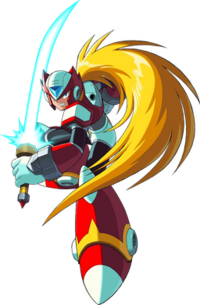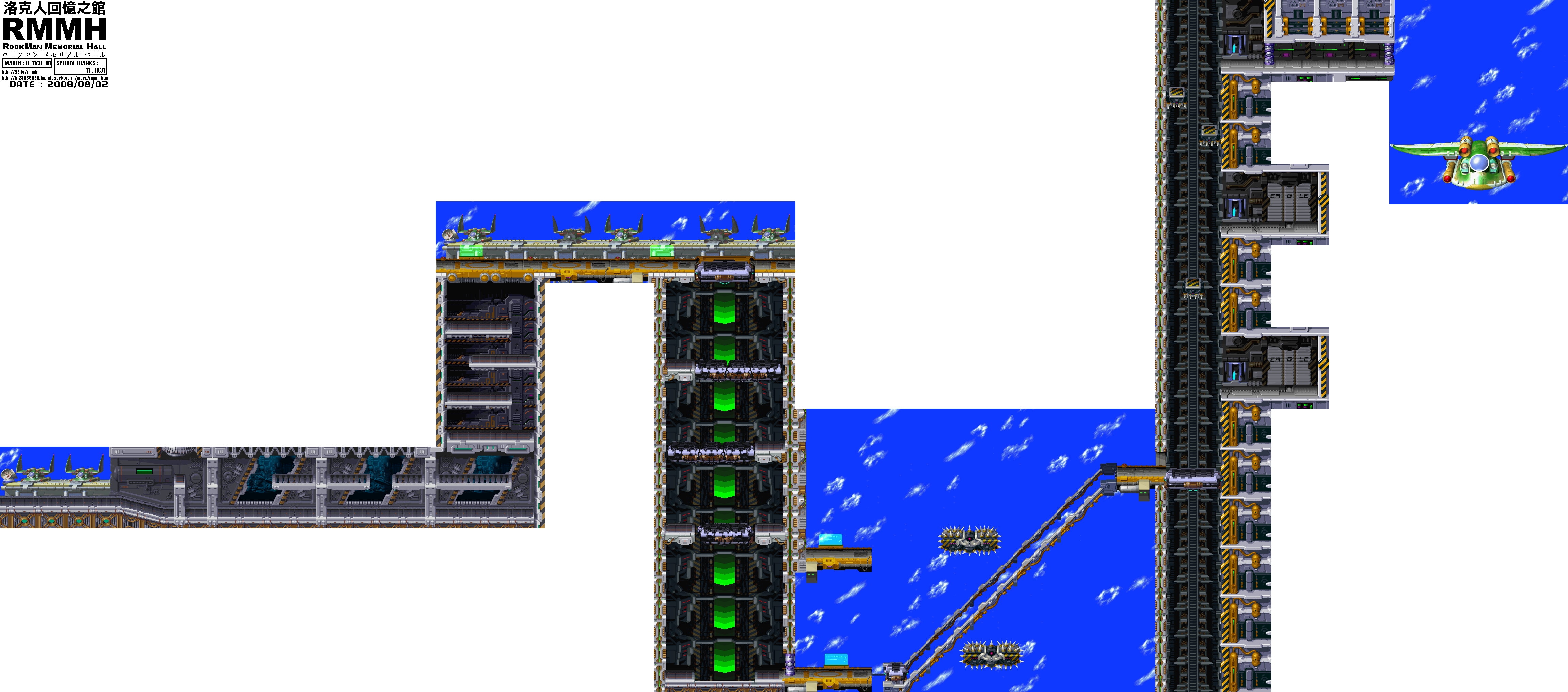 |
| Image courtesy of Wikipedia. |
So, I just replayed the first stage of Mega Man X5 again for the first time in a long while. A long while. Just out of whimsy, a random fling.
No, that's a lie; it was totally because of this fucking awesome remix on OCRemix's Mega Man X collaboration album, Maverick Rising. I got the nostalgias bad from it.
 |
| Source |
Anyway, Mega Man X5, like all of the games in the Mega Man X series, starts you off in an introductory stage; as in all of them from 4 and on, you can choose to play either as Mega Man X or Zero. I picked Zero, just for kicks, and started playing. 5's opening stage places you in a wrecked city, running down the street and then through a collapsing building, and then up the (strangely bulky and mechanical) scaffolding surrounding a large statue, the head of which becomes the opening boss.
 |
| Credit where credit is due: this sequence is pretty artistically legit. Too bad the rest of the game is plain old silly. :P Source |
And that is all of the game it took to remind me why I hate the Playstation Mega Man X games so, so much. I can't stand them. They make me sick, not with anger or disgust, but with sadness and regret.
Please keep in mind, this is not part of my hard-core analysis schtick. This is my opinion, yadda-yadda. Lots of people like those games; hell, I used to love the ever-loving excrement out of them. But it is my considered opinion that they are, taken as a whole, one of the more spectacular failures of a previously top-quality series in gaming history.
And now that I am older and wiser and have given much thought to game mechanics and design, I think I understand what went wrong. Who killed Mega Man X? The answer is this guy, right here:
 |
| Image courtesy of Wikipedia. |
Oh God, here it comes.
Before anyone rises to Zero's defense, let me explain. I love the character as much as anyone else; hell, he's practically bad-ass incarnate. He steals all the good scenes and there's not a single one of us X players who didn't want to be Zero, dashing in with our long, blonde hair flowing behind us and green
But he didn't work. He just didn't work. Not as a character, it's true; the heavy drama weighed too hard on a series that was too cartoonish to support it, and the cutscenes got in the way of our bloody platforming ("I don't care if Zero is dying for the third time now, I just want to play my game!"). But the real problems lay in what Zero did to the series' gameplay. Let's take a quick glance, and only a quick glance, since this is just a little side-trip:
First, let's take a look at some stage layouts real quick. Here's Storm Eagle's stage from Mega Man X, the premier (and also best) game in the series:
 |
| Source |
Notice the large blocks of terrain (the opening area on the left is four screens tall and wide, I think). The stage is about freedom of movement; wide open areas to dodge enemy fire and retaliate, nooks and crannies to explore, and a whole lot of sky to keep things in perspective.
Now, here's something from Mega Man X5, The Skiver's stage (the sky-based Maverick, and therefore analogous to Storm Eagle):
 |
| Source |
That's the bloody sky stage. THE SKY STAGE. It's a series of one-screen-wide gray corridors broken up by exactly two areas of free-scrolling; and of those, one of them is an elevator that you can only leave if you have X's Falcon Armor and has only one 'hidden' area, and the other is the boss chamber.
Not convinced? Let's look at another comparison. Here's Sting Chameleon's stage, also from X:
This one's a lot more strictly horizontal and constrained, but look at all the different kinds of terrain! We move from a light jungle area to a cave (including optional branching paths both up and down, the upper of which contains a mini-boss that yields both an Armor piece and a change to the stage dynamics, and the latter of which changes if the player has beaten Launch Octopus already), to more jungle, to a small mountain that must be scaled, to a thicker jungle, to a swamp, to a clearing. This stage is alive with dynamic changes.
Now here's another stage from X5, Dark Dizzy's:
It somehow manages to be both busy and monotone at the same time, and it's flat. Flat and unchanging; for your reference, the constellations in the top map turn into enemy ambushes (which quickly become tiresome and annoying), while the terrain becomes very boring in the second part, with constant predictable traps doing little more than slowing the player down, and only one optional path with a puzzle to get an Armor Piece near the end.
The problems aren't just limited to stage design, either. For the Playstation iterations, the Dash move's speed was cut almost in half; running is also slower. Jumping feels less precise, perhaps due to the loss of clear tile-based layouts and the constant use of 2.5D perspective. Enemy behaviors feel more sedate, and placement seems less creative.
Some of this was due to laziness and loss of talent on the developers' part, no doubt; CAPCOM had plenty of big-money, big-plan projects for the Sony Playstation, and it's likely that those sucked top-level talent away from the Mega Man X projects. I don't know for sure, though.. Some of it was certainly due to a loss of clear direction in the series; the writing alone is enough to show me that. But it wasn't all that. Some of it was a deliberate adaptation, and I'll tell you what it was a deliberate adaptation to:
 |
| That purple fabulousness right there. Source. |
Zero's mechanics were more suitable to a beat-em-up game than a classic platformer of the style the Mega Man games had always been; and, in a way, the developers were smart to make changes to allow for this. But in doing so, they lost a lot of what made the series great to begin with - expansive, varied environments, creative enemy arrangements with wild behaviors, the supreme freedom of movement and the joy that came with learning to control it, all of these were pretty much gone from 4 onward. It was a great loss for the platformer genre, and to this day no series that I know of has really stepped up to replace it. Perhaps now that Metroidvanias are the standard format and the days of carefully crafted, refined obstacle-course stages are gone, none ever will.
But I sure hope not.
....
This fucking remix. I tell you what, man. It's the bee's knees.



No comments:
Post a Comment